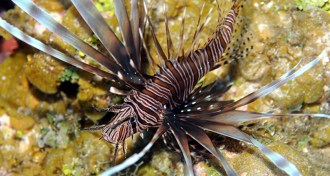Earth
Sign up for our newsletter
We summarize the week's scientific breakthroughs every Thursday.
-

-

-
 Humans
HumansAAAS board defends climate scientists
“AAAS vigorously opposes attacks on researchers that question their personal and professional integrity or threaten their safety based on displeasure with their scientific conclusions.” This declaration was contained in a 400-word denunciation of attacks on climate scientists and the politicization of climate science that was issued June 29 by the organization's board of directors.
By Janet Raloff -
 Earth
EarthBPA makes male mice less macho
Studies show that exposures in the womb or during adolescence can erase masculine habits or reverse sexes' behavior.
By Janet Raloff -
 Animals
AnimalsLionfish no match for big groupers
Despite its invasive success, the lionfish can't withstand grouper appetites.
By Janet Raloff -
 Earth
EarthFloodwaters may trigger fault motion
In sediments under California’s Salton Sea, geologists find evidence for a natural disaster one-two punch.
By Devin Powell -
 Earth
EarthEarth/Environment
Platypuses in trouble, toxins in lakes and a chemical link to early puberty in this week’s news.
By Science News -
 Paleontology
PaleontologyBig dinosaurs kept their cool
Body temperature of long-gone beasts resembled that of mammals, study of fossil teeth suggests.
-
 Earth
EarthModern-day sea level rise skyrocketing
A spike that began during the 19th century appears to be linked to rising temperatures and increasing greenhouse gases.
By Janet Raloff -
 Earth
EarthEarth & Environment
Earth’s bulging waistline, plus ancient mangrove swamps and new threats from wildfires in this week’s news.
By Science News -
 Earth
EarthDeath of a Continent, Birth of an Ocean
Africa’s Afar region gives glimpses of geology in action.
-
 Humans
HumansCouch potatoes: Where the risks lie
Several new studies finger television viewing as a potentially unhealthy pastime. I know, that hardly sounds surprising. For years, research has been linking hours in front of TV screens with an elevated risk of developing heart disease and diabetes, not to mention obesity. But what makes the recent spate of analyses different, researchers argue, is that they’re finally homing in on consistent estimates of the magnitude of risks — and hints at what underlies them.
By Janet Raloff